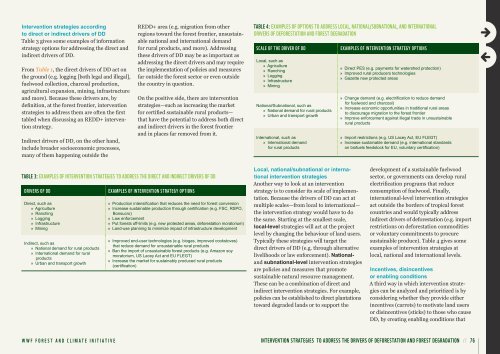WWF Guide to Building REDD+ Strategies
WWF Guide to Building REDD+ Strategies
WWF Guide to Building REDD+ Strategies
You also want an ePaper? Increase the reach of your titles
YUMPU automatically turns print PDFs into web optimized ePapers that Google loves.
Intervention strategies according<br />
<strong>to</strong> direct or indirect drivers of DD<br />
Table 3 gives some examples of information<br />
strategy options for addressing the direct and<br />
indirect drivers of DD.<br />
From Table 1, the direct drivers of DD act on<br />
the ground (e.g. logging [both legal and illegal],<br />
fuelwood collection, charcoal production,<br />
agricultural expansion, mining, infrastructure<br />
and more). Because these drivers are, by<br />
definition, at the forest frontier, intervention<br />
strategies <strong>to</strong> address them are often the first<br />
tabled when discussing an <strong>REDD+</strong> intervention<br />
strategy.<br />
Indirect drivers of DD, on the other hand,<br />
include broader socioeconomic processes,<br />
many of them happening outside the<br />
taBle 3: examPleS oF inteRvention StRateGieS <strong>to</strong> addReSS tHe diReCt and indiReCt dRiveRS oF dd<br />
dRiveRS oF dd examPleS oF inteRvention StRateGy oPtionS<br />
Direct, such as<br />
» Agriculture<br />
» Ranching<br />
» Logging<br />
» Infrastructure<br />
» Mining<br />
Indirect, such as<br />
» National demand for rural products<br />
» International demand for rural<br />
products<br />
» Urban and transport growth<br />
<strong>WWF</strong> FOREST AND CLIMATE INITIATIVE<br />
<strong>REDD+</strong> area (e.g. migration from other<br />
regions <strong>to</strong>ward the forest frontier, unsustainable<br />
national and international demand<br />
for rural products, and more). Addressing<br />
these drivers of DD may be as important as<br />
addressing the direct drivers and may require<br />
the implementation of policies and measures<br />
far outside the forest sec<strong>to</strong>r or even outside<br />
the country in question.<br />
On the positive side, there are intervention<br />
strategies—such as increasing the market<br />
for certified sustainable rural products—<br />
that have the potential <strong>to</strong> address both direct<br />
and indirect drivers in the forest frontier<br />
and in places far removed from it.<br />
» Production intensification that reduces the need for forest conversion<br />
» Increase sustainable production through certification (e.g. FSC, RSPO,<br />
Bonsucro)<br />
» Law enforcement<br />
» Put forests off-limits (e.g. new protected areas, deforestation mora<strong>to</strong>rium)<br />
» Land-use planning <strong>to</strong> minimize impact of infrastructure development<br />
» Improved end-user technologies (e.g. biogas, improved cooks<strong>to</strong>ves)<br />
that reduce demand for unsustainable rural products<br />
» Ban the import of unsustainable forest products (e.g. Amazon soy<br />
mora<strong>to</strong>rium, US Lacey Act and EU FLEGT)<br />
» Increase the market for sustainably produced rural products<br />
(certification)<br />
taBle 4: examPleS oF oPtionS <strong>to</strong> addReSS loCal, national/SuBnational, and inteRnational<br />
dRiveRS oF deFoReStation and FoReSt deGRadation<br />
SCale oF tHe dRiveR oF dd examPleS oF inteRvention StRateGy oPtionS<br />
Local, such as<br />
» Agriculture<br />
» Ranching<br />
» Logging<br />
» Infrastructure<br />
» Mining<br />
National/Subnational, such as<br />
» National demand for rural products<br />
» Urban and transport growth<br />
International, such as<br />
» International demand<br />
for rural products<br />
Local, national/subnational or international<br />
intervention strategies<br />
Another way <strong>to</strong> look at an intervention<br />
strategy is <strong>to</strong> consider its scale of implementation.<br />
Because the drivers of DD can act at<br />
multiple scales—from local <strong>to</strong> international—<br />
the intervention strategy would have <strong>to</strong> do<br />
the same. Starting at the smallest scale,<br />
local-level strategies will act at the project<br />
level by changing the behaviour of land users.<br />
Typically these strategies will target the<br />
direct drivers of DD (e.g. through alternative<br />
livelihoods or law enforcement). National-<br />
and subnational-level intervention strategies<br />
are policies and measures that promote<br />
sustainable natural resource management.<br />
These can be a combination of direct and<br />
indirect intervention strategies. For example,<br />
policies can be established <strong>to</strong> direct plantations<br />
<strong>to</strong>ward degraded lands or <strong>to</strong> support the<br />
» Direct PES (e.g. payments for watershed protection)<br />
» Improved rural producers technologies<br />
» Gazette new protected areas<br />
» Change demand (e.g. electrification <strong>to</strong> reduce demand<br />
for fuelwood and charcoal)<br />
» Increase economic opportunities in traditional rural areas<br />
<strong>to</strong> discourage migration <strong>to</strong> the forest frontier<br />
» Improve enforcement against illegal trade in unsustainable<br />
rural products<br />
» Import restrictions (e.g. US Lacey Act, EU FLEGT)<br />
» Increase sustainable demand (e.g. international standards<br />
on biofuels feeds<strong>to</strong>ck for EU, voluntary certification)<br />
development of a sustainable fuelwood<br />
sec<strong>to</strong>r, or governments can develop rural<br />
electrification programs that reduce<br />
consumption of fuelwood. Finally,<br />
international-level intervention strategies<br />
act outside the borders of tropical forest<br />
countries and would typically address<br />
indirect drivers of deforestation (e.g. import<br />
restrictions on deforestation commodities<br />
or voluntary commitments <strong>to</strong> procure<br />
sustainable produce). Table 4 gives some<br />
examples of intervention strategies at<br />
local, national and international levels.<br />
Incentives, disincentives<br />
or enabling conditions<br />
A third way in which intervention strategies<br />
can be analyzed and prioritized is by<br />
considering whether they provide either<br />
incentives (carrots) <strong>to</strong> motivate land users<br />
or disincentives (sticks) <strong>to</strong> those who cause<br />
DD, by creating enabling conditions that<br />
inteRvention StRateGieS <strong>to</strong> addReSS tHe dRiveRS oF deFoReStation and FoReSt deGRadation // 76

















